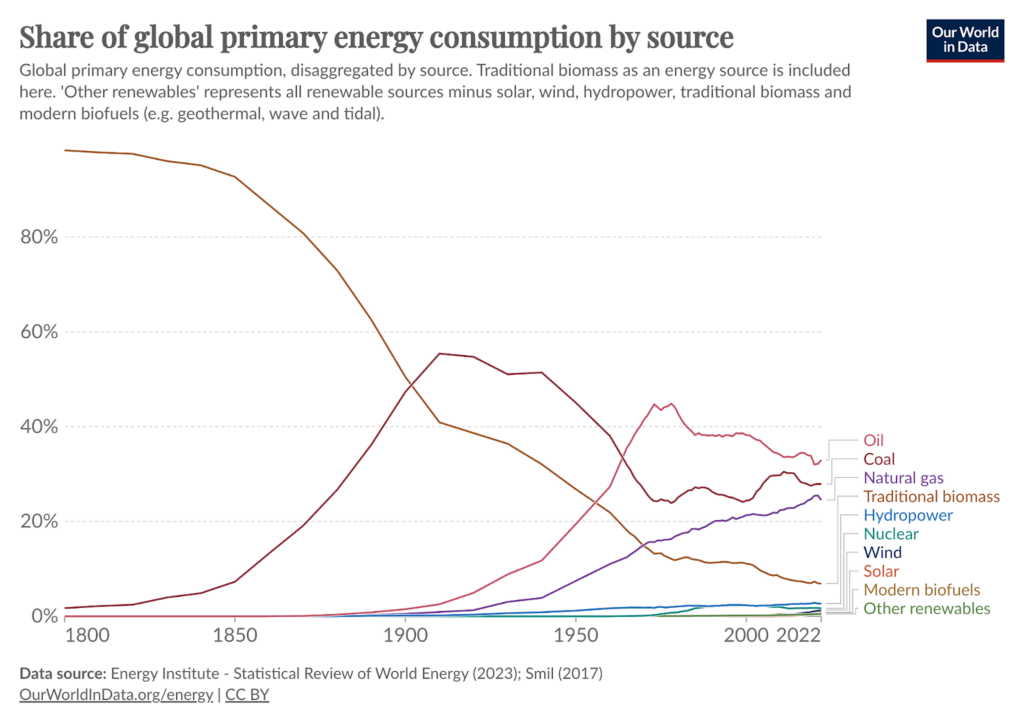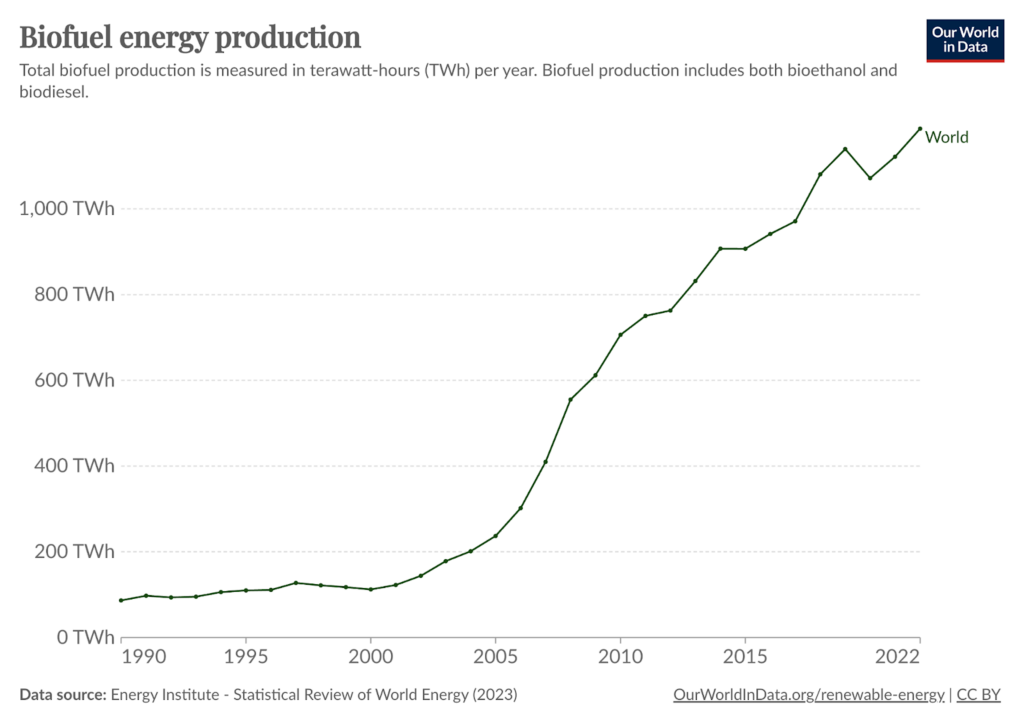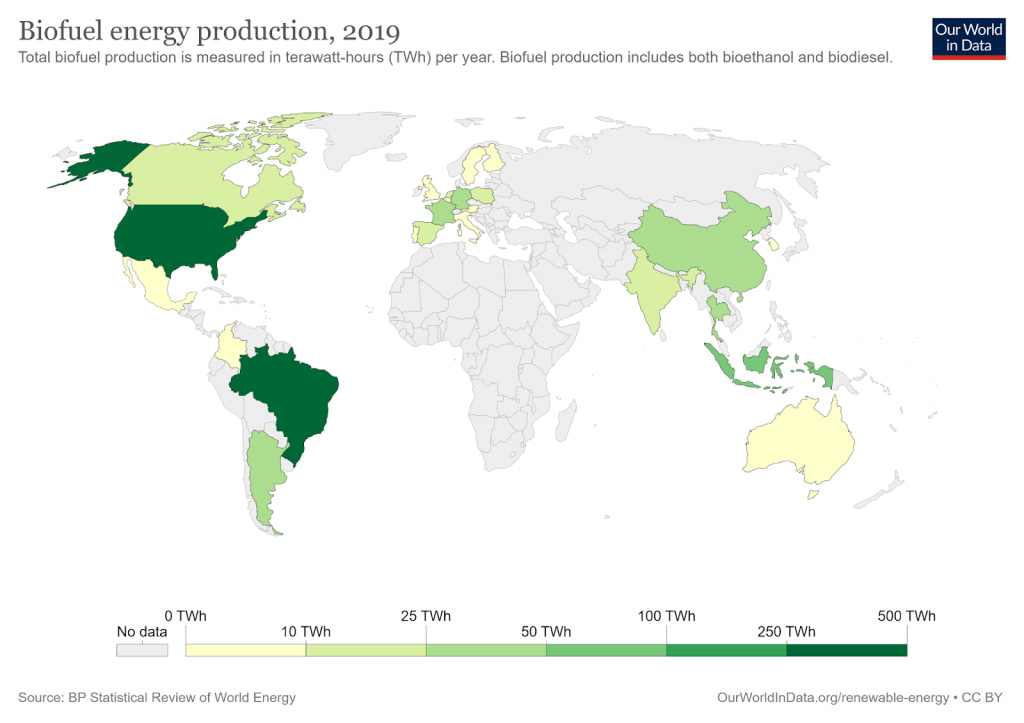The History of Biomass: The Big Picture
Impactful Ninja is reader-supported. When you buy through links on our site, we may earn an affiliate commission.
Learn more
Learn more
.
Hey fellow impactful ninja ? You may have noticed that Impactful Ninja is all about providing helpful information to make a positive impact on the world and society. And that we love to link back to where we found all the information for each of our posts. Most of these links are informational-based for you to check out their primary sources with one click. But some of these links are so-called "affiliate links" to products that we recommend. First and foremost, because we believe that they add value to you. For example, when we wrote a post about the environmental impact of long showers, we came across an EPA recommendation to use WaterSense showerheads. So we linked to where you can find them. Or, for many of our posts, we also link to our favorite books on that topic so that you can get a much more holistic overview than one single blog post could provide. And when there is an affiliate program for these products, we sign up for it. For example, as Amazon Associates, we earn from qualifying purchases. First, and most importantly, we still only recommend products that we believe add value for you. When you buy something through one of our affiliate links, we may earn a small commission - but at no additional costs to you. And when you buy something through a link that is not an affiliate link, we won’t receive any commission but we’ll still be happy to have helped you. When we find products that we believe add value to you and the seller has an affiliate program, we sign up for it. When you buy something through one of our affiliate links, we may earn a small commission (at no extra costs to you). And at this point in time, all money is reinvested in sharing the most helpful content with you. This includes all operating costs for running this site and the content creation itself. You may have noticed by the way Impactful Ninja is operated that money is not the driving factor behind it. It is a passion project of mine and I love to share helpful information with you to make a positive impact on the world and society. However, it's a project in that I invest a lot of time and also quite some money. Eventually, my dream is to one day turn this passion project into my full-time job and provide even more helpful information. But that's still a long time to go. Stay impactful,Affiliate Disclosure
Why do we add these product links?
What do these affiliate links mean for you?
What do these affiliate links mean for us?
What does this mean for me personally?
![]()
Humans have been using biomass for centuries, beginning with the discovery of fire. Over the years, we have transitioned away from burning biomass directly and toward converting it into gaseous and liquid fuels. These modern forms of biomass could play a crucial part in mitigating climate change for years to come. So, we had to ask: What is the history of biomass?
Biomass energy began thousands of years ago with humans first burning organic matter for heating and cooking. The rise of the modern biogas industry began with advances in the biogas and biofuel industries. Since the turn of the 21st century, modern biomass has been part of mainstream energy.
Keep reading to learn how biomass came to be, who and what pioneered its development, how effective it has been thus far, and what the future of biomass could entail.
Here’s the History of Biomass in a Nutshell
Biomass is renewable, organic material derived from plants and animals. To harvest biomass energy, different biomass sources are burned or converted to release stored chemical energy from the sun.
“Biomass: natural materials from living or recently dead plants, trees and animals, used as fuel and in industrial production, especially in the generation of electricity”
Oxford Dictionary
Biomass energy has been split into two categories, traditional biomass energy and modern biomass energy. Traditional biomass involves the combustion of biomass sources directly to produce energy and heat. In contrast, modern biomass involves converting biomass sources into gaseous and liquid fuels (e.g., biogas, ethanol, and biodiesel).
Biomass has gone through three distinct development phases in its development:
- Early market formation and innovation: The early history of biomass dates back hundreds of thousands of years with the discovery of fire as an early form of traditional biomass, biogas as an early form of heat, and alcohol and vegetable oil as early forms of liquid biofuels.
- Consolidation and strengthening: The modern biomass industry began in the 1800s with technological advances that saw the focus shift away from traditional biomass and towards the biogas and biofuel industries. Petroleum shortages during the 1st and 2nd World Wars and the 1970s Energy Crisis sparked interest in biomass as an energy source and spurred technological advances.
- Mainstreaming: Modern biomass began to establish itself as a major player in the renewable energy industry in the 21st century. The establishment of The International Energy Agency, the World Bioenergy Association, the World Biogas Association, and the Global Biofuel Alliance have helped to shape the modern biomass industry.
| Biomass Milestones | Historical Event |
| Initial start | The early history of biomass dates back hundreds of thousands of years with the discovery of fire as an early form of traditional biomass, biogas as an early form of heat, and alcohol and vegetable oil as early forms of liquid biofuels. |
| Milestones in biomass development | 1808: Sir Humphrey Davy established that cow manure produced methane. Manure would become a prominent feedstock for biogas today. 1826: Samuel Morey invented the internal combustion engine, which could run on ethanol and turpentine. The engine powered a small boat up a river in the US. 1857: French Chemist Louis Pasteur discovered the fermentation process, the main pathway to produce ethanol. 1859: The first anaerobic digestion plant—essential to convert organic waste into biogas—was constructed in a leper colony in Bombay (presently Mumbai), India. 1860: German inventor Nicolaus Otto developed a more efficient internal combustion engine, the Otto Cycle Engine, which used ethyl alcohol as a fuel. 1890s: German engineer Rudolph Diesel invented the world’s first diesel engine, which could run on a variety of fuels, including vegetable oil. 1895: Biogas was recovered from the sewage system in Exeter (United Kingdom) and used to light street lamps. 1906: Karl Imhoff invented the Imhoff Tank, a two-chambered tank to receive and process sewage. His design would become an early form of biogas plants in operation today. 1908: Henry Ford invented the Model-T car, the world’s first car that could run on ethanol as fuel. 1914-1918: Petroleum became the dominant fuel in World War I, leading to a decreasing interest in biomass as an energy source. 1930s: Microbiology became a recognized scientific discipline, which led to a massive amount of research taking place on anaerobic digestion, bacteria, and methane to produce biogas. 1937: A patent was granted to Chavanne G. for an ethyl ester of palm oil, a substance which today we call biodiesel. This constituted the first report on biodiesel. 1938: Biodiesel was tested for the first time in vehicles. A bus running on palm oil ethyl ester made the trip between Brussels and Louvain (Belgium). 1939-1945: Petroleum shortages during World War II caused interest in biomass to surge. When the war ended, interest in biomass again decreased as petroleum availability returned to normal levels. 1950s: Activated sludge systems became established as a way to apply anaerobic digestion to solid waste. 1970s: The Energy Crisis of 1970, caused by disruptions to the supply chain via wars in the Middle East, renewed interest in modern biomass. 1970s: China adopted anaerobic digestion technology on a massive scale in the form of small household digesters. 1985: The world’s first biodiesel manufacturing plant was established at an agricultural college in Austria. It was specifically designed to produce biofuel. 1991: Germany became the first country in the world to implement feed-in tariffs (FIT) to support the expansion of anaerobic digestion technology. 1992: Biodiesel began to be commercially manufactured in Europe, with Germany as the largest producer. |
| Current status | Currently, nearly 3 billion people worldwide still rely on the burning of traditional biomass to meet their basic household energy needs. The global demand for modern biomass is roughly 5 times higher than that of solar and wind energy combined. |
| Future outlook | The future of biomass energy will require ambitious government targets, policy support, increasing competitiveness of biomass energy companies, and decreasing the upfront costs associated with installing biomass technologies. However, meeting short-term climate goals will require a reduction in traditional biomass usage and an increase in modern biomass energy usage. |
| Key policy developments | 1974 – The International Energy Agency (IEA) 1978 – IEA Bioenergy Technology Collaboration Programme (IEA BTCP) 2008 – World Bioenergy Association 2009 – The International Renewable Energy Agency (IRENA) 2016 – World Biogas Association 2023 – Global Biofuel Alliance (GBA) |
Understanding biomass’ history can provide insight into how it has evolved into the energy source it is today.
When and How Did Biomass Get Started
Humans have been using traditional biomass for centuries, dating all the way back to when we discovered fire hundreds of thousands of years ago. Up until the 19th century (the 1800s), traditional biomass (e.g., wood, crop waste, charcoal, and dung) was the dominant source of energy worldwide. Usage dropped significantly in the 20th century (the 1900s) and even further in the 21st century (the 2000s) as interest in modern biomass increased.
Humans have also been using modern biomass for centuries, albeit in more primitive ways:
- Humans have known about and harnessed biogas energy for centuries, dating back to 900 BC when the Assyrians used biogas to heat their bathwater. In the 1600s, Jan Baptist van Helmont discovered that flammable gasses could be produced from decaying, organic matter. Then, Count Alessandro Volta discovered methane emissions from naturally occurring aerobic sites (soils and oceanic basins) in 1776. His discovery would form the basis of how we view anaerobic digestion today.
- The first liquid biofuel usage dates back to 4,000 BC when humans used vegetable oil as fuel for their pottery lamps. Although we have been indulging in alcohol since the dawn of civilization, the distillation of alcohol into ethanol was not achieved until the 800s, possibly by Arabian alchemists.
How Has Biomass Developed Over Time
Traditional biomass has gone from being the dominant energy source in the world to only a fraction of what it once was. On the other hand, modern biomass demand and usage has increased as the climate crisis continues to worsen.
What Are Milestones in Biomass Development
The modern biomass industry began in the 1800s and saw growth in part due to World War II and fluctuations in the petroleum industry.
1808: Sir Humphrey Davy established that cow manure produced methane. Manure would become a prominent feedstock for biogas today.
1826: Samuel Morey invented the internal combustion engine, which could run on ethanol and turpentine. The engine powered a small boat up a river in the US.
1857: French Chemist Louis Pasteur discovered the fermentation process, the main pathway to produce ethanol.
1859: The first anaerobic digestion plant—essential to convert organic waste into biogas—was constructed in a leper colony in Bombay (presently Mumbai), India. Little is known about the plant except it was built to manage sewage in the colony.
1860: German inventor Nicolaus Otto developed a more efficient internal combustion engine, the Otto Cycle Engine, which used ethyl alcohol as a fuel.
1890s: German engineer Rudolph Diesel invented the world’s first diesel engine, which could run on a variety of fuels, including vegetable oil.
1895: Biogas was recovered from the sewage system in Exeter (United Kingdom) and used to light street lamps.
1906: German engineer Karl Imhoff invented the Imhoff Tank, a two-chambered tank to receive and process sewage. His design would become an early form of biogas plants in operation today. It also signaled a switch from anaerobic lagoons to anaerobic tank systems.
1908: Henry Ford invented the Model-T car, the world’s first car that could run on ethanol as fuel.
1914-1918: Petroleum became the dominant fuel in World War I, leading to a decreasing interest in biomass as an energy source.
1930s: Microbiology became a recognized scientific discipline, which led to a massive amount of research taking place on anaerobic digestion, bacteria, and methane to produce biogas.
1937: A patent was granted to Chavanne G. for an ethyl ester of palm oil, a substance which today we call biodiesel. This constituted the first report on biodiesel.
1938: Biodiesel was tested for the first time in vehicles. A bus running on palm oil ethyl ester made the trip between Brussels and Louvain (Belgium).
1939-1945: Petroleum shortages during World War II caused interest in biomass to surge. When the war ended, interest in biomass again decreased as petroleum availability returned to normal levels.
1950s: Activated sludge systems became established as a way to apply anaerobic digestion to solid waste to create biogas.
1970s: The Energy Crisis of 1970, caused by disruptions to the petroleum supply chain via wars in the Middle East, renewed interest in biomass energy.
1970s: China adopted anaerobic digestion technology on a massive scale in the form of small household digesters that use biogas.
1985: The world’s first biodiesel manufacturing plant was established at an agricultural college in Austria. It was specifically designed to produce fuel.
1991: Germany became the first country in the world to implement feed-in tariffs (FIT) to support the expansion of anaerobic digestion technology. The number of anaerobic digestion plants grew from 20 to over 500 between 1991 to 1998.
1992: Biodiesel began to be commercially manufactured in Europe, with Germany as the largest producer.
2000: Biogas production began to increase noticeably, increasing more than fivefold from 0.29 to 1.46 exajoules between 2000 and 2022.
How Has the Biomass Market Developed Recently
The share of global primary energy consumption coming from traditional biomass has decreased from 95% in the 1800s to less than 7% in 2022.

Global biogas production has increased from over 7 billion cubic meters in 2000 to over 38 billion cubic meters in 2020. Europe, China, and the United States are the well-established world leaders in biogas, with some African countries more recently scaling up their biogas industries.
Global biofuel demand has increased by roughly 6% per year since 2016. Biofuel energy production has increased from 112 terawatt-hours (TWh) in 2000 to 1,187 TWh in 2022.

What Is the Present Status of Biomass
Presently, modern biomass accounts for the majority of our renewable energy generation, but traditional biomass still remains a key component of some developing countries economies.
What Is the Present Status of Traditional Biomass
Over 35% of biomass usage in 2022 came from traditional biomass, mainly from cooking over open fires.
Whereas developed countries have transitioned away from traditional biomass, some developing countries still rely on it heavily. Nearly 3 billion people worldwide still rely on the burning of traditional biomass to meet their basic household energy needs, and 2.3 billion still use traditional biomass for cooking. Countries that continue to rely heavily on traditional biomass include Niger, Kenya, Tanzania, Nigeria, the Democratic Republic of Congo, and Haiti.
What Is the Present Status of Modern Biomass
The global demand for modern biomass is roughly five times higher than that of solar and wind energy combined, and modern biomass currently accounts for over 50% of our renewable energy and over 6% of our global energy supply.
In terms of biogas, we currently have over 50 million micro-biodigesters, 132,000 small/medium/large scale biodigesters, and 700 upgrading plants (to produce biomethane) in operation worldwide. Europe, China, and the US account for 90% of global biogas production.
Biofuels accounted for roughly 3.5% of the global transportation energy demand in 2022. The US, Brazil, Indonesia, China, and Germany are the five largest biofuel-producing countries in the world, accounting for roughly 75% (900 TWh) of global biofuel production (1,187 TWh).

How Will the Future of Biomass Look Like
The future of biomass energy will require a reduction in traditional biomass usage and an increase in modern biomass energy usage. Ambitious government targets, policy support, increasing competitiveness of modern biomass energy companies, and decreasing the upfront costs associated with installing modern biomass technologies will be key to meeting short-term, greenhouse gas emission reduction goals.
How Biomass Will Likely Develop in the Future
The International Energy Agency’s (IEA’s) Net Zero by 2050 Scenario calls for the use of traditional biomass to fall to zero by 2030 due to its negative effects on human health and the environment. In reality, nearly 3 billion people worldwide still rely on the burning of traditional biomass to meet their basic household energy needs, a number which is not forecasted to drop dramatically in the coming years.
The IEA’s Net Zero by 2050 Scenario calls for a rapid increase in modern biomass, roughly 8% per year from 2022-2030.
- The biogas industry is forecasted to grow at a 5% compound annual growth rate between 2020 and 2030, and estimates suggest that its market value will increase from $58 billion in 2022 to $89 billion by 2030. Developing countries in Asia are predicted to lead direct biogas demand, and the share of biogas used for power and heat is predicted to increase from 70% today to 85% by 2040.
We can potentially generate between 10 and 14 thousand terawatt-hours (TWh) of biogas energy from biomass feedstocks, the equivalent of meeting 6-9% of the world’s energy consumption, 23-32% of the world’s coal consumption, and 16-22% of the world’s electricity consumption.
- The biofuels industry is forecasted to grow at an 11.3% compound annual growth rate between 2024 and 2030, and estimates suggest that its market value will increase from $117 billion in 2022 to over $200 billion by 2030. Nearly two-thirds of biofuel demand growth is predicted to occur in emerging economies (e.g., India, Brazil, and Indonesia).
Ethanol can potentially reduce greenhouse gas emissions by 32-62% when compared with gasoline, and B20 (a form of biodiesel) could reduce emissions from carbon monoxide by 12.6%, hydrocarbons by 11%, particulates by 18%, and air toxics by 12-20%.
What Policies Are Put in Place to Support Modern Biomass Usage
Although traditional biomass remains a key part of some developing countries, it has been gradually phased out of most developed countries due to the recognition that it produces significant amounts of carbon emissions and air toxics.
For this reason, global biomass policies have been aimed at increasing modern biomass usage and continuing to phase out traditional biomass usage whenever possible.
The most well-known piece of legally binding, international climate mitigation legislation is The Paris Agreement, the goal of which is to limit global warming to below 2 degrees Celsius (C), preferably to 1.5°C, compared to pre-industrial levels.
The Paris Agreement specifically notes a transition towards renewable energies, like modern biomass, as being a critical part of meeting these goals. This includes reducing traditional biomass usage and increasing modern biomass usage.
Check out the highlights of the 2015 COP21 directly from the UN Climate Change channel:
In addition, The International Energy Agency’s (IEA) Net Zero Emissions by 2050 Scenario is one framework for the global energy sector to achieve net zero carbon dioxide (CO2) emissions by 2050 and universal energy access by 2030.
Because of this, there are many global and country-specific biomass energy policies and organizations aimed at meeting the 2050 net zero scenario, including:
- 1974 – The International Energy Agency (IEA): The IEA was founded in response to the major oil disruptions in 1974. It promotes international energy cooperation and is made up of 31 member countries.
- 1978 – IEA Bioenergy Technology Collaboration Programme (IEA BTCP): The IEA BTCP is an independent organization operating under a framework laid out by the IEA which seeks to advance knowledge and understanding of bioenergy systems.
- 2008 – World Bioenergy Association: The World Bioenergy Association was founded to sustainably develop bioenergy globally and promote the business environment of bioenergy.
- 2009 – The International Renewable Energy Agency (IRENA): IRENA was founded as a global intergovernmental agency focused on scaling renewable energy. It is comprised of 167 member countries as well as the European Union.
- 2016 – World Biogas Association: The World Biogas Association was established as the global trade association for the biogas, landfill gas, and anaerobic digestion sectors.
- 2023 – Global Biofuel Alliance (GBA): The GBA was launched at the G20 summit as an alliance between 19 countries and 12 international organizations to advance the development of sustainable biofuels.
If you are interested in learning more about country-specific biomass energy policies, you can visit the IEA’s bioenergy policy database.
What Are Currently the Different Types of Biomass
The two different types of biomass are traditional biomass and modern biomass. Sources of biomass can include wood, wood processing wastes, agricultural crops, agricultural waste materials, municipal solid waste, animal manure, and human sewage, depending on the type.
Traditional biomass involves the combustion of biomass sources directly to produce energy and heat. This typically involves burning wood or wastes as sources of heat or for cooking purposes.
Modern biomass involves chemically or biologically converting biomass sources into different products including:
- Biogas: Biogas is a gaseous mixture of 45% to 75% methane (CH4), carbon dioxide (CO2), and small quantities of other gasses created through anaerobic digestion or thermochemical conversion of biomass in an oxygen-free environment. Biogas is either burned to create electricity or can be further purified down into renewable natural gas (i.e., biomethane) which can be used in place of conventional natural gas (NG).
- Biofuels: Biofuels include fuels made from crops such as corn, sugarcane, hemp, and cassava. The two most common biofuels used for transportation are ethanol and biodiesel. Transesterification is used to convert vegetable oil, animal fat, and grease into biodiesel, and fermentation is used to convert biomass into ethanol.
Final Thoughts
The early history of biomass dates back hundreds of thousands of years with the discovery of fire as an early form of traditional biomass, biogas as an early form of heat, and alcohol and vegetable oil as early forms of liquid biofuels.
Petroleum shortages during the 1st and 2nd World Wars and the 1970s Energy Crisis sparked interest in biomass as an energy source and spurred technological advances. In the 21st century, modern biomass began to establish itself as a major player.
The establishment of the International Energy Agency, the World Bioenergy Association, the World Biogas Association, and the Global Biofuel Alliance have helped to shape the modern biomass industry. More efforts are still needed if modern biomass is to play a key role in mitigating climate change.
Stay impactful,

Sources
- US Energy Information Administration: Biomass explained
- International Energy Agency: Bioenergy
- International Energy Agency: Homepage
- World Bioenergy Association: Homepage
- World Biogas Association: Homepage
- Global Biofuel Alliance: Homepage
- HISTORY: Human Ancestors Tamed Fire Earlier Than Thought
- Our World in Data: How have the world’s energy sources changed over the last two centuries?
- World Biogas Association: Why biogas?
- Britannica: Jan Baptista van Helmont | Flemish Physiologist, Chemist & Physician
- Birch Solutions: The History of Anaerobic Digestion and Biogas
- Lee Enterprises Consulting: A Short History of Biofuels
- QUBE Renewables Ltd: A brief history of anaerobic digestion
- Linda Hall Library: Samuel Morey
- Nature: Yeast Fermentation and the Making of Beer and Wine
- National Grid Group: What is biogas?
- Alpha Holdings: Ethanol History
- Britannica: Rudolf Diesel | Inventor of Internal Combustion Engine, Automotive Pioneer
- Merriam-Webster: Imhoff tank Definition & Meaning
- Wood Energy: Ethanol from Biomass
- Britannica: World War I
- Acta Scientific: Experimental Studies on Production of Biodiesel from Oryza sativa (Rice) Bran Oil
- IntechOpen: Production and Characterization of Biofuel from Refined Groundnut Oil
- Britannica: World War II
- ScienceDirect: Municipal Solid Waste to Bioenergy: Current Status, Opportunities, and Challenges in Indian Context
- Federal Reserve History: Oil Shock of 1973–74
- Investopedia: Feed-In Tariff (FIT) – Explanation, History and Uses
- Statista: Global production of biogas
- Our World in Data: Share of global primary energy consumption by source
- World Bioenergy Association: Global Bioenergy Statistics 2022
- International Energy Agency: Global biofuel demand in transport in the Net Zero Scenario, 2016-2030 – Charts – Data & Statistics
- Our World in Data: Biofuels production
- Our World in Data: Biofuel energy production
- US Environmental Protection Agency: Household Energy and Clean Cookstove Research
- WorldAtlas: What is Biomass? Which Countries Burn the Most Biomass?
- World Biogas Association: Global Potential of Biogas
- International Energy Agency: Biofuels – Energy System
- Our World in Data: Biofuel energy production, 2022
- Statista: Forecast global biogas market value 2020-2030
- International Energency Agency: The outlook for biogas and biomethane to 2040 – Outlook for biogas and biomethane
- European Biogas Association: Anaerobic digestion has the potential to reduce global GHG emissions with 10-13%
- Grandview Research: Biofuels Market Size, Share, Growth & Trends Report, 2030
- Statista: Biofuels global market size 2030
- Renewable Fuels Association: Ethanol and the Environment
- US Office of Energy Efficiency and Renewable Energy: Biodiesel Basics
- The United Nations Framework Convention on Climate Change: The Paris Agreement
- International Energy Agency: Net Zero Emissions by 2050 Scenario (NZE) – Global Energy and Climate Model – Analysis
- IEA Bioenergy Technology Collaboration Programme: Homepage
- The International Renewable Energy Agency: Homepage
- International Energy Agency: Policies – Bioenergy
- National Renewable Energy Laboratory: Biomass Energy Basics
- Our World in Data: Renewable Energy
- Impactful Ninja: What Is the Carbon Footprint of Ethanol? A Life-Cycle Assessment
- Impactful Ninja: What Is the Carbon Footprint of Biodiesel? A Life-Cycle Assessment
- Impactful Ninja: Biomass Energy Explained: All You Need to Know





